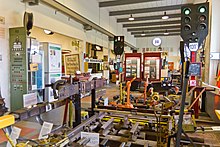Berlin S-Bahn Museum
 Exhibits in the museum |
|
| Data | |
|---|---|
| place | 14482 Potsdam -Griebnitzsee, Rudolf-Breitscheid-Strasse 203 |
| Art |
Service building
|
| architect | Richard Brademann |
| opening | End of December 1996, regular museum operations began in spring 1997 |
| Number of visitors (annually) |
1500-2000 |
| operator |
Museum S-Bahn e. V.
|
| management |
Udo Dittfurth
|
| Website | |
| ISIL | DE-MUS-958518 |
The S-Bahn Museum for the Berlin and Brandenburg area was located in Potsdam at the Griebnitzsee station . The museum was opened in 1996 in a substation of the S-Bahn and officially started operations in 1997. The focus of the exhibition was the history of the S-Bahn Berlin with its technology and rolling stock.
The museum closed temporarily in December 2016, so that it will probably be able to reopen in 2019 at a new location in Berlin.
history
The basis for the museum were mainly exhibits from the 1980s, when the Berliner Verkehrsbetriebe took over the S-Bahn operations for the lines in West Berlin from the Reichsbahn . A second major addition to the exhibition were rolling materials and technology from signal boxes, train stations and disused or modernized lines from the 1990s. Members of the Berlin Passenger Association (IGEB) had saved these pieces from being scrapped after the fall of the Wall .
In the mid-1990s, the desire arose to be able to show the collected pieces to the public. Those interested founded a museum association and looked for exhibition space. They found them on a floor of around 500 square meters in a substation at Griebnitzsee station, where the power supply for the S-Bahn line between Berlin and Potsdam was installed. The building was built in 1927/28 according to plans by Richard Brademann . Several hundred people visited the museum on the opening days.
The voluntary members of the museum association look after the collection and work without financial subsidies from the federal states or the state.
Due to the rapid increase in museum exhibits and the relatively large amount of space required, there was no possibility of growth or modernization of the presentation on the upper floor of the former railway works; Access was also not handicapped accessible . At the same time, Deutsche Bahn AG , which owns the company building and operates a substation on the ground floor , is now claiming the entire building for its own purposes. In coordination between the museum management and DB Energie as the landlord, the tenancy agreement was terminated by mutual agreement on December 10, 2016. A new location in Berlin was sought together, the negotiations dragged on. In spring 2017, those involved wanted to present the modernized exhibition concept and a schedule for the move until the reopening. Initially, the plan was to use an empty DB service building on Frankfurter Allee and reopen it at the beginning of 2018 (status at the end of December 2016.)
Finally, the people involved in the planning of the move found suitable premises with the subsequent use of a fast-service restaurant in the station building on Weitlingstrasse that opened in the 1990s and had been vacant for a long time . The rooms have an area of 450 square meters. The exhibition concept provides a “mixture of information and emotion” using modern media and is to concentrate on 15 themed stations in a “showroom on the history of the S-Bahn”. A museum shop could be set up in the passenger center of the IGEB passenger association in the basement of the station building. In order to prepare and provide financial security, those involved signed a letter of intent in February 2018 , including the promise of 15 years of rent-free use. On this basis, the museum association will apply to the Senate for funding, the approval of which depends on the assurance of an own contribution of ten percent of the construction and operating costs. The modernized S-Bahn Museum is scheduled to reopen in 2019, but the construction site could be opened to visitors once on the occasion of the 90 years of electrical rail operation in Lichtenberg on November 6, 2018.
Museum fund (selection)
|
|
Web links
Individual evidence
-
↑ a b c d Peter Neumann: Train instead of burgers. The S-Bahn Museum is set to open in Lichtenberg in 2019 with a new concept. Letter of intent signed. In: Berliner Zeitung , February 12, 2018, p. 9 (print edition).
“More than a means of transport” The new S-Bahn museum in Lichtenberg is to open in 2019 (online edition) . - ^ A b c Peter Neumann: Historical Collection - the S-Bahn Museum is to move to Berlin (online) In: Berliner Zeitung , December 19, 2016; (Print edition: Next station: Berlin ), December 19, 2016, p. 16.
- ^ Susanne Dost, Richard Brademann: 1884-1965: Architect of the Berlin S-Bahn , Verlag B. Neddermeyer, Berlin 2002, ISBN 3-933254-36-1 , p. 99.
Coordinates: 52 ° 23 '43.2 " N , 13 ° 7' 49.4" E
